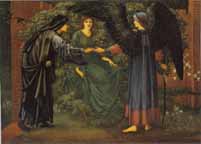 Sir Edward Burne-Jones's painting, The Heart of the Rose (1889) forms the final portion of a triptych loosely based on Chaucer's legend of the Romaunt of the Rose. The other two paintings include The Pilgrim at the Gate of Idleness (1884), a companion painting to The Heart of the Rose, and Love Leading the Pilgrim (1877-1897), the largest of the three.
Sir Edward Burne-Jones's painting, The Heart of the Rose (1889) forms the final portion of a triptych loosely based on Chaucer's legend of the Romaunt of the Rose. The other two paintings include The Pilgrim at the Gate of Idleness (1884), a companion painting to The Heart of the Rose, and Love Leading the Pilgrim (1877-1897), the largest of the three.
The trilogy details the pilgrim's triumph over temptation and struggle to reach his ultimate desire, the rose bush, which essentially represents his elusive love. The Pilgrim at the Gate of Idleness begins the series with the pilgrim encountering the temptation of Idleness, disguised as a charming woman. The pilgrim resists her and subsequently, Love leads him to yet another obstacle — a briar thicket — in the next work, Love Leading the Pilgrim. To finish the series, Burne-Jones painted The Heart of the Rose, in which Love finally leads the pilgrim to his desired destination — a rose bush. In the image, a beautiful maiden sits within the bush, dressed in a long green dress and directly gazing at the viewer, as if posing for a portrait. In the picture's foreground, Love and the Pilgrim stand to the left and right of the Rose and grasp each other's hands across her mid-section. Burne-Jones renders a relatively simple background that consists of a red brick wall and some grass and white flowers. He also suggests a forest both to the left of the picture plane and, to a lesser extent, above the brick wall.
As with Burne-Jones's Briar Rose sequence, this particular series reflects his strong interest in the briar rose — a beautiful flower protected by thorns. According to Bill Waters, "they [briar roses] came to symbolize his experience of love which brought both pleasure and pain -- the pleasure in an idealised loved one which simultaneously brought about feelings of despair and ultimate loss."
Discussion Questions
1. Burne-Jones's attitude toward love soured later in his life, and his later artwork reflected this shift. As in his painting, Souls on the Banks of the River Styx (1873), the artist's figures became melancholy and he exhibited a, "preference for scenes of disappointed love" (Wood). In what ways does The Heart of the Rose echo this more somber attitude toward love? Would you consider the piece to be more pessimistic or optimistic?
2. Waters compares The Heart of the Rose to the final painting of the Sleeping Beauty series, which portrays the Princess marrying the Prince. He emphasizes that both pieces display men in awe of, "beauty enthroned." Do you consider the Rose figure worthy of comparison to a Princess? Does Burne-Jones effectively give her a regal appearance?
3. The Pilgrim and Love wear similar colors -- Burne-Jones depicts both in blue garments supplemented by black elements, including Love's long black cloak and the Pilgrim's large black wings. What effect do these similar colors have on the composition?
4. Prior to the creation of this series, in roughly 1872, Burne-Jones collaborated with long-time friend William Morris to create designs for wall-hangings based on Chaucer's poem. These designs served as the basis for Burne-Jones's painted series. Why did Burne-Jones decide to paint the images in addition to designing the wall-hangings?
References:
Waters, Bill. Burne-Jones -- A Quest for Love: Works by Sir Edward Burne-Jones Bt and Related Works by Contemporary Artists. London: Peter Nahum, 1993. Catalogue number 7.
Wood, Christopher. The Pre-Raphaelites. New York: Studio/Viking, 1981.
Last modified 28 October 2004